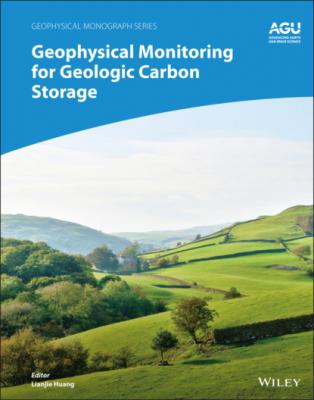Geophysical Monitoring for Geologic Carbon Storage. Группа авторов
Чтение книги онлайн.
Читать онлайн книгу Geophysical Monitoring for Geologic Carbon Storage - Группа авторов страница 45
 indicate this may be attributed to different porosity distribution and bedding structure in the samples.
indicate this may be attributed to different porosity distribution and bedding structure in the samples.
Frac Ib, Ic, and Id samples containing core‐parallel, sheared fractures (average aperture 0.54 mm, determined from X‐ray CT images) showed much smaller Young's and shear moduli than the intact core, which, interestingly, did not change during scCO2 injection. In contrast, attenuation increased monotonically until scCO2 broke through the core. The final scCO2 saturation was much smaller (7%–9.5%) than for the intact core, because of the fast‐passing effect of the open, permeable fracture.
For the samples Frac IIa and Frac IIb containing core‐perpendicular, sheared fractures (average aperture 0.26 mm), Young's modulus showed similar behavior as the intact sample, decreasing monotonically as scCO2 saturation increased. (Note that Frac IIa shows much smaller final scCO2 saturation compared with the core‐parallel cases and the Frac IIb, because the scCO2 fast passed along the Mylar layer.) However, upon close examination, the changes in the modulus exhibited more complexity. Unlike the intact sample's Young's modulus, which showed the most rapid changes at the beginning of the scCO2 injection (saturation <~10%), the Young's modulus of the fractured samples dropped most quickly at intermediate scCO2 saturations. Such differences in the behavior were even more prominent for the attenuation: in contrast to the smooth and more‐or‐less monotonic changes for the intact sample, the fractured samples showed a sharp peak in the attenuation followed by an abrupt decrease, and subsequent gradual increases.
Compared with the changes in the Young's modulus during the scCO2 injection, shear modulus and its related attenuation were largely unchanged during the experiment (Fig. 5.6).
This indicates that the observed changes in the Young's modulus are attributed to the mechanical, poroelastic effect, rather than changes in the rock's mineral properties caused by chemical interactions with the injected scCO2.
Fluid Phase Distribution
Saturation of the pore space by scCO2 was determined by obtaining CT images of the cores for (1) initial dry state (pore space filled with air), (2) water‐saturated state, and (3) partially scCO2 saturated state. Knowing the densities of the fluids contained in the pore space, the average scCO2 saturation within each CT imaging voxel was computed via linear interpolation.
For intact cores (Fig. 5.7, top left columns), scCO2 migrated more or less uniformly but with higher saturations within layers containing larger pores (because of the stronger capillary entry pressure in the smaller pores) along the bedding planes. For core‐parallel fractures, the mated fracture (Frac Ia) contributed to somewhat localized distribution of scCO2. However, the scCO2 was still well dispersed throughout the core, possibly because the void space within the fracture was highly disconnected and did not result in an efficient fast path for the scCO2.
In contrast, for core‐parallel fractures with large shear displacement (Frac Ib and Frac Id are shown in Fig. 5.7), almost all the scCO2 migrated through the fracture, and little scCO2 infiltrated into the rock matrix. Also, because of the large aperture of the fracture (~0.54 mm), the vertically oriented fracture in Frac Id exhibited preferential pooling of lighter scCO2 in water along the top edge of the fracture by the buoyancy effect.
For a core‐perpendicular fracture, the migration behavior of scCO2 was initially similar to the intact core, exhibiting a wide distribution of the fluid across the core with preferential flow along the bedding planes. However, the fracture (aperture ~0.26 mm) served as a trap and accumulated scCO2 before the second half of the core was infiltrated.
5.4. DISCUSSION
In this section, we will examine the experimentally observed behavior of Young's modulus and related attenuation during scCO2 injection.
5.4.1. Gassmann Model Interpretation of Young's Modulus Behavior
Detailed dynamic poroelastic modeling of the experimental results is beyond the scope of this chapter. However, we can gain some insights into the observed behavior of fractured samples using a simple, isotropic, quasi‐static model (i.e., isotropic Gassmann model).
Figure 5.6 Shear modulus and related attenuations determined from SHRB tests during scCO2 injection experiments on Carbon Tan sandstone cores: (a) Carbon Tan #1 elastic moduli; (b) Carbon Tan #2 elastic moduli; (c) Carbon Tan #1 attenuations; (d) Carbon Tan #2 attenuations.
In the following, we consider only small stress and displacement perturbations caused by seismic waves. For the porous, intact matrix of the sandstone samples, we assume the following constitutive equations for an isotropic homogeneous poroelastic medium (e.g., Pride et al., 2002):
Figure 5.7 X‐ray CT images of scCO2 invasion into intact and fractured sandstone cores. Brighter colors indicate higher CO2 saturation. Average apertures determined from CT images are indicated for open, sheared fractures. (Note that at the top of the Frac IIb images, unintended shifts of the experimental setup between an initial calibration scan and subsequent scans during the scCO2 injection experiment resulted in false images of scCO2 along the bottom edge of the core, which disappear in the subsequent images.)
In 5.3 and 5.4, repeated indices indicate summation, and, i ≡ ∂/∂x i . u i is the local average solid frame displacement vector. w i ≡ φ (U i ‐ u i ) is the relative fluid volume displacement vector defined via u i , local average fluid displacement vector in the pore